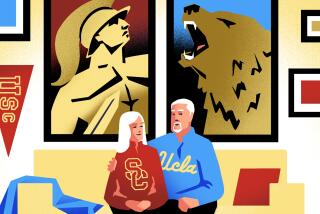Class Reunions Graduate to Big Business : Celebrations: Pros will book the hall, order the dinner and even find those long-lost alumni. ‘It is a money machine,’ one organizer says.
- Share via
The letter arrives. It’s from your old schoolmates of 20 years ago. There’s going to be a class reunion at some hotel.
It’s only $60 per person, so you write a check and send it in. And Beth Simon gets a little bit richer.
Because it’s not Vicki the cheerleader or Debbie the class secretary who’s organizing this do. It’s Simon, her computer and her 12 full-time employees in Chatsworth.
By year’s end, more than $1.35 million will have flowed through her firm, the Reunion Committee. In return, 22,500 former jocks, car clubbers, class presidents and nerds will munch chicken dinners and dance to the music of their teens.
Professional reunion companies have cropped up in metropolitan areas all over the country during the past decade, and although many wither and die, some are doing well.
Simon was one of the first in the business. The idea struck her eight years ago, when she was a housewife struggling to help stage a reunion for her husband’s high school class.
It was a typical experience, she said. “You start out with a committee of 16 people. You get together, and it takes months to decide where, when. You have little subcommittees: ‘You look for entertainment, you look for decoration and we’ll meet next month.’
But by the end of the process, she said, both interest and the size of the committee had dwindled. “My husband and I wound up fronting a lot of money.
“After it was all over, I thought to myself, ‘Somebody should do this for a living.’ ”
About the same time, Steve and Erna Drucker were forming Great Reunions Inc. in Orange County.
“This is the best business I’ve ever been in,” said Steve Drucker. “It is a money machine.” He said his firm will stage events for 34,000 people this year.
“There is just no doubt in my mind that we are a business because of the rise of the two-income family,” he said. “Organizing reunions is something women used to do. They headed all the committees. And when they started going into the work force, there wasn’t anyone around to take over.”
Adopting the tactics tour companies have long employed, reunion companies guarantee large groups of customers in exchange for large discounts from hotels, caterers and suppliers. With more than 400 high schools in Los Angeles and Orange counties alone, most large area hotels are hosting one or more reunions every Saturday night through mid-September.
“We bring a hotel 20 or 30 reunions a year, and they are going to be a lot more flexible with us than with a volunteer committee that is coming once and will never be back,” Drucker said.
That keeps the ticket price within the $50- to $65-a-person range that seems to maximize attendance.
Alumni of Los Angeles and Orange county schools are more willing to pay that much than grads from other Southern California areas, said Joe Gutierrez, a former Great Reunions employee who owns High School Reunions Co. in Orange.
“If the price goes much higher, people won’t come,” said Sonny Reeder, president of Reunions Are Magical in Anaheim. Reunions involving theme parties or cruises usually cost more, but they are few.
Attendance is crucial, because small turnouts put a dent in the firms’ balance sheets. With rare exceptions, they must plop down deposits and guarantee to pay for a minimum number of dinners.
In the winter before the reunions are scheduled, the deposit outlay peaks. “We’ll have $50,000 to $70,000 out in deposits at hotels” six months before the ticket money starts coming in, said Drucker.
“The hotels generally get $6 to $8 per person as a deposit,” said Reeder, “and we also have to pay out deposits to hold photographers, printers, decorations, the disc jockeys. . . . It isn’t cheap.”
So reunion organizers help find “lost” alumni to maximize attendance, offering it as part of the service. Researchers scan voter and property rolls from Ventura to San Diego counties. It typically takes about 40 hours of research to assemble the initial list of graduates.
Organizers also follow trends. Their conclusions:
* Attendance is usually poor at five-year reunions. The alums are still in college or struggling at new jobs. Attendance is just as bad at 15-year reunions when many lives are in flux.
* Ten-year reunions are unpredictable, because money can be tight for families. “But attendance typically is highest at the 10-year reunion, because a lot of people are still around the area and interested in what their old classmates are doing,” Steve Drucker said.
* Attendance stabilizes at the 20-year reunion and remains strong through the 40th.
* August is the peak month for reunions in Southern California.
* Middle-income schools have the biggest reunion turnouts. “The graduates of poor and rich schools usually get quite widely scattered for job and social reasons,” Steve Drucker said. “And the people from wealthy schools generally all want to be chiefs, so nobody does the work that has to be done to make it a successful reunion.”
* Ironically, the alma mater makes the worst location for a reunion. “When you try to get nostalgic and go back to the old school, you usually find out that the neighborhood has gone downhill or the gym is a lot rattier than you remember, and everyone gripes about paying $50 to go to a sock hop. It just doesn’t work,” Steve Drucker said.
The business seems to be fairly recession-proof, despite lagging revenues, organizers say. Checks are coming in more slowly than in boom times.
“People are procrastinating,” said Reeder. “They’ll come to their reunion, but this year they’re waiting as long as they can to write those checks.”
More to Read
Inside the business of entertainment
The Wide Shot brings you news, analysis and insights on everything from streaming wars to production — and what it all means for the future.
You may occasionally receive promotional content from the Los Angeles Times.








